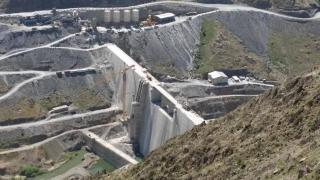This is the seventh case study from SUEUAA (Strengthening Urban Engagement in Universities in Asia and Africa), written by Dr Nematollah Azizi of the University of Kurdistan. The project is interested in how Universities in the Global South can contribute to solving geographical, economic and social issues in their cities. The project is looking at six cities in six different countries: Harare (Zimbabwe), Dar-es-Salaam (Tanzania), Johannesburg (South Africa), Manilla (Philippines), Duhok (Iraq), and Sanandaj (Iran). The SUEUAA project involves academics from each of these cities, who will be carrying out fieldwork, and elite interviews with decision makers in the city and senior academics from local Universities, to better understand the ability of Universities to respond to city issues.
In this seventh case study, we look at how the University of Kurdistan in Iran has responded to the negative environmental impacts on both urban and surroundings areas of dam construction in Kurdistan.
The increasing demand of humans for fresh water sources as well as energy production has led to constant attention to damming as one of the main pillars of developmental approaches. Moreover sustainable management of scarce agricultural water resources is an unavoidable necessity for countries facing the incremental water demands and suffering from water deficiencies, such as Iran [1]. In order to reserve the limited existent water resources, dam building can potentially help the more efficient use and allocation of them. But the ecological and environmental damages caused by the construction of dams must be assessed critically.
Kurdistan province, with a total area of 29,000 square kilometres, has 17 permanent rivers, and 24 rivers of seasonality. The region produces 6.6% of the country’s waterflow, and has 3.1% of the country’s precipitation. According to the governor of Kurdistan Regional Water Authority, three first-class watersheds in the country are located in Kurdistan [2]. Despite this, and in the line with the country’s policies for sustainable development, in the time of the Shah only two Gheshlag and Kazemi dams were built in the province, which were used exclusively for the drinking water supply source in Sanandaj and West Azarbaijan.
Therefore due to the rainfall and the good potential of surface waters in Kurdistan province and the use of water and soil resources in recent twenty years, the dam construction industry has entered a new stage in Kurdistan. Recently, the construction of 12 dams was completed; with another eight other dams under construction and the study plan for the construction of another 14 dams has begun in Kurdistan [3, 4].
The dam construction industry in Kurdistan has an important job, as it has to balance a number of competing issues: controlling and developing water resources, supply increased drinking water, generate hydro-electricity, supply water to agriculture and industry, and also to develop sustainable flood control and food management policies. These have to be understood within the wider context of improving the environment of the rivers (including reinforcing of underground acquifiers in the plains), and encourage local employment and recreational opportunities. However, dam construction risks negative environmental and large scale social impact if these are not handled correctly.
One such consequence is the negative impact on rural populations. Construction of dams has led to the compulsory purchase of land and displacement of large part of the rural population, including those from historic sites. This leads to an increase in displaced and marginalised populations, poverty, and unemployment in Sanandaj. In addition to this, the allocated water from the dams cover less than 10% of Kurdistan’s agricultural lands, meaning the resources produced are not being given to local people. Finally, it also creates negative environmental impacts affecting the regions climate and ecosystem. These include: water pollution; air pollution; soil contamination; sound pollution; sediment (worsened through policies of sedimentation in the Province of Kurdistan); regional climate change; change in the shape of the earth; and destroying ecosystem (affecting plants and indigenous animals’ habitats).
Many departments at the University of Kurdistan have been engaged toward lowering the negative environmental impacts on both urban and surroundings areas. There have been studies exploring the impact of the dam construction on the natural and social environments. The findings of this, which will be discussed in more depth in a later publication, have found that implementing the policy of further dam construction without true comprehensive assessment of its consequences, especially for target communities, can practically lead to destruction of surface water resources and deprivation of natural and human ecosystems from these essential resources [5].
Findings of this study were used to successfully petition both dam construction project managers, and local officials to reconsider their construction plans. Academics in the Department of Urban and Natural Resources at the University of Kurdistan consulted with these officials to decrease the height of the Javeh and Daryan dams by 30 metres.
Academics at the University of Kurdistan believe that the evidence base they have collated can be used to stop damages in a number of sensitive areas, and may be used to employ more effective strategies and new methods for maximising outputs of natural resources. These new methods should have an evidence base behind them, with all future construction projects requiring a critical appraisal.
References:
[1] Azizi, V. (2015). A reflection on Environmental impacts of Reflection on the Environmental Impacts of Dam Construction: A Case Study of Jahve Dam. Project Report, University of Kurdistan.
[2] Kurdistan Regional Water Authority (2018). Dam Construction In Kurdistan: Emerging Area for Development. http://www.kdrw.ir/
[3] Amini, A., and Goftari, Z. (2017). Assessment of the Influence of Zhaveh Dam on the Neighboring Rural Areas: Sanandaj County. Journal of Geography and Regional Development, 15 (1): 47-52.
[4] MOSHANIR (2018). ZHAVEH RESERVOIR DAM & WATER TRANSFER SYSTEMhttp://www.moshanir.co.ir/ En/zhaveh.aspx

